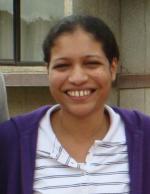DNA Damage Undone
Namrata Jayanth, a PhD student in Mrinalini Puranik's lab at NCBS was recently awarded a highly competitive travel award to attend the 2011 annual meeting of the American Society for Biochemistry and Molecular Biology in Washington. Below, Namrata talks about the conference and her research.
Namrata, is this your first big international conference?
It's my first outside India but I have been to many conferences in India, the most recent being a DNA repair workshop in Hyderabad last month. One of the reasons I want to go to the US is to visit labs where I might do a post-doc, and in addition to interact with other people in the field. It's a huge affair with six concurrent sessions. I'm very interested in some of the research of the people who will be at the meet. In Hyderabad, I already had a chance to show my work to a few of the top researchers in the field of enzymology, some of whom are the keynote speakers in the Washington conference. I obtained useful inputs regarding our data and I hope to get some more feedback from them.
Raman spectroscopy seems to be one of those fields that can attract very methodologically oriented people. What's most important for you, the biology or the techniques?
It is both the biology and the technique. Resonance Raman spectroscopy is one of the most suitable techniques to answer the questions we are asking, related to enzyme-substrate recognition. Raman spectroscopy is a field that is moving ahead all the time, because people keep using it to address new types of questions. I was studying a stable complex, but other people have used it to study kinetics, and so time-resolved Raman spectroscopy has evolved. Raman microscopy is another new development, that you can use to study cells, and we got a Raman microscope in the lab a few months back, on which experiments are already in progress.
Have the origins of Raman spectroscopy in India made it a popular technique here?
Not so much. There are only a handful of Raman labs in India and fewer still that are addressing questions pertaining to biology with the Raman technique. It's rather an expensive approach.
Where does the work that you will be presenting in Washington fit into your PhD program?
My PhD work is mainly looking at the structure-function relationship of DNA repair enzymes. When I started my project I was just focusing on one enzyme and subsequently started on a second. Both enzymes are involved in the repair of DNA bases. The first enzyme, Fpg, repairs bases that have been oxidised, and the second, AlkB, repairs those that have been methylated. Oxidative damage is very common - too much exposure to UV for example will cause an increase in free radicals in the cells, and they can then damage the DNA bases. Many groups dealing with repair enzymes and related fields will be presenting at the conference.
These repair enzymes have a more difficult job than your average enzyme?
Yes, all enzymes must be able to identify the molecules they interact with, but for a repair enzyme this is a remarkable feat. There is considerable structural variety amongst the damaged bases that the enzyme must recognise. This variety is at two levels: the four bases themselves (adenine, guanine, thymine, cytosine) and then, for any one base, the various alterations brought about during damage. There must be some common feature amongst the various damaged bases that is recognised by the enzyme and the whole system must work very differently from the standard lock-and-key recognition model that underpins typical enzyme-molecule interactions.
This makes everything rather efficient.
Yes, from an evolutionary and energetic point of view it is very useful, the cell can make one enzyme do a lot of work!
If the repair enzymes are not recognising their targets via a shape-based cue, what are they recognising as the common feature of the damaged bases?
From our results, we find that it is of course the modification of the base, and also in many cases it appears to be a change in charge that is the cue. Normally the bases are neutral in terms of charge, so what is added to the base during damage might lead to the base being electron-deficient, that is, it acquires a positive charge. Once the recognition occurs, these enzymes can actually reorganise their active site - where they link up with the damaged base - depending upon the precise nature of the damage. At which point the interaction of enzyme and base will transition to the lock-and-key system.
Are any bases more vulnerable to damage than the others?
Yes when it comes to oxidation, it's guanine, but for methylation, it's adenine and cytosine.
What are the applications of this type of research?
One interest of the group is to look at selectively inhibiting these repair enzymes in cancer cells. That would kill them, but leave normal cells alone. The drugs would need to be designed to target the cancer cells. But practical applications are all in the future.
Talking about which, I hear you're about to start writing up?
Yes I meet with my thesis committee next week, and hopefully I will have the go-ahead to proceed, and will get it all done by June.
Comments
Post new comment